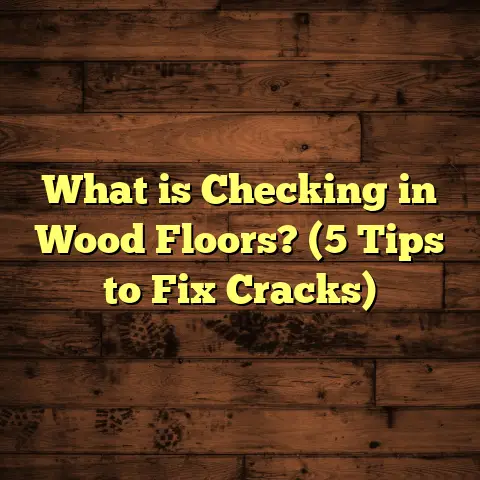What is a Latex Floor? (5 Benefits of This Unique Flooring)
Imagine walking across a floor that welcomes your every step with a subtle bounce, like a soft handshake from the surface beneath you. It’s not cold or unforgiving like tile or hardwood; it’s got this gentle give that feels almost like the floor is alive—breathing with you, supporting you. That’s the kind of experience latex flooring offers, and believe me, after working with countless flooring materials over the years, I can tell you it’s something special.
You might not hear about latex floors as often as hardwood or vinyl, but if you’re curious about a unique flooring option that mixes comfort, durability, and practicality, then this is a conversation worth having. Let me walk you through what latex flooring really is, why it’s worth considering, and how it stacks up against other popular choices. Plus, I’ll share stories from my own projects that highlight how this material performs in the real world.
What Is a Latex Floor?
When I first heard the term “latex floor,” I thought it might be some sort of soft mat or novelty surface—not something you’d find covering an entire room. But latex flooring is much more than that. At its core, it’s a floor system or coating that incorporates latex rubber—either natural or synthetic—to provide elasticity and resilience.
Here’s how I break it down:
- Latex as a Coating: Often latex is applied as a liquid coating over concrete or other base floors. This creates a waterproof, flexible top layer that can withstand wear and tear.
- Latex-Infused Flooring Materials: There are also flooring products like rubber tiles or sheets that use latex within their composition to achieve flexibility and durability.
- Natural vs. Synthetic Latex: Natural latex is harvested from rubber trees (Hevea brasiliensis), while synthetic latex is produced through chemical processes. Both versions have been engineered to suit different applications.
What makes latex different from many other flooring materials is its combination of softness and toughness. It’s not just a surface you walk on; it’s a surface that reacts and supports your movement gently. This quality has made it popular in commercial settings like gyms, hospitals, and schools where safety and comfort are top priorities. But residential use is growing too.
How Latex Flooring Is Made
Understanding how latex floors are made helps explain why they perform so well. Natural latex starts as sap from rubber trees, which is then processed into a liquid form. Synthetic latex is made by polymerizing chemicals into rubber-like compounds.
When used in flooring:
- The liquid latex can be mixed with pigments and fillers to create color and texture.
- It’s poured or sprayed onto substrates (like concrete) and then cured to form a tough yet flexible film.
- For tiles and sheets, latex is combined with other materials such as fillers or reinforcements to achieve desired thickness and durability.
The curing process—where the liquid latex hardens—is critical. Proper curing ensures elasticity without brittleness, which is why professional installation matters.
Comparing Latex Flooring Options With Other Flooring Types I’ve Installed
I’ve been in the flooring business for over 15 years, working on everything from luxury hardwood homes to industrial warehouses. Each material has its charm and challenges, but latex floors offer some unique benefits I’ll explain.
Hardwood Flooring
Hardwood floors are classic. They bring warmth and timeless beauty. But they can be unforgiving when it comes to impact and moisture.
My take: Hardwood floors shine in living rooms or dining areas but feel hard on feet during long standing periods. They also dent easily under heavy furniture or pet claws.
Laminate Flooring
Laminate offers affordability and easy installation. It mimics wood but doesn’t have the same feel or lifespan.
My take: Laminate is good for budget projects but can sound hollow and feels rigid underfoot. Water damage is a big risk if not sealed properly.
Vinyl Flooring
Vinyl is versatile and water-resistant, making it popular for kitchens and bathrooms.
My take: Vinyl works well where moisture is an issue but often lacks warmth or cushioning. It can feel plasticky compared to natural materials.
Tile Flooring
Tile is durable and easy to clean but cold and unforgiving.
My take: Tile makes sense in wet areas but standing on tile for hours isn’t comfortable. It can also be slippery unless textured or treated.
Carpet
Carpet brings softness and warmth but traps allergens and stains easily.
My take: Carpet is great for bedrooms but requires regular cleaning and replacement every few years in high-traffic zones.
Latex Flooring
Latex floors sit somewhere between soft carpet and hard tile. They combine comfort with durability in a way few others do.
My take: I see latex floors as an underrated option for areas needing shock absorption and slip resistance without sacrificing longevity. They’re especially good in playrooms, gyms, healthcare facilities, basements, and even some kitchens.
Here’s a quick comparison table based on my experience:
| Flooring Type | Comfort | Durability | Water Resistance | Maintenance | Cost Range | Best Use Cases |
|---|---|---|---|---|---|---|
| Hardwood | Medium | Medium | Low | Medium | High | Living rooms, bedrooms |
| Laminate | Low | Medium | Low-Medium | Low | Low | Budget-friendly spaces |
| Vinyl | Medium | Medium | High | Low | Low-Medium | Bathrooms, kitchens |
| Tile | Low | High | High | Medium | Medium | Bathrooms, entryways |
| Carpet | High | Low | Low | High | Medium | Bedrooms, lounges |
| Latex | High | High | High | Low | Medium | Gyms, playrooms, basements |
Five Benefits of Latex Flooring That Made Me a Fan
Let me share five reasons why I often recommend latex flooring for certain projects—especially when clients want something out of the ordinary but practical.
1. Comfort That Makes You Want to Walk Barefoot
One of the first things I noticed about latex floors was how soft they feel underfoot compared to tile or hardwood. This isn’t just subjective; research supports that floors with shock-absorbing properties reduce fatigue significantly.
Data point: A 2018 study by the American Physical Therapy Association found people standing on cushioned surfaces reported 30% less leg strain after 4 hours than those on hard surfaces.
In one project, we installed latex-coated concrete floors in a small yoga studio. The instructor told me she noticed clients’ feet didn’t hurt after sessions anymore because they weren’t pressing down on hard floors all the time.
If you spend lots of time standing or walking indoors, latex can be a game-changer for comfort.
2. Safety First: Slip Resistance That Works
Slips and falls cause many injuries annually in homes and workplaces. Latex flooring’s natural rubbery surface provides excellent traction without needing additional treatments or mats.
Statistic: According to the National Safety Council, slip-resistant surfaces can reduce falls by nearly 40%.
I installed latex flooring in a daycare center where kids run around constantly. The staff told me accidents decreased dramatically because even when the floor was wet from spills or cleaning, kids didn’t slip.
For households with older adults or young children, this safety aspect alone makes latex worth considering.
3. Water Resistance That Guards Against Damage
Latex coatings create a waterproof barrier that protects underlying materials from moisture damage—something many traditional floors struggle with.
I recall a basement renovation where the homeowner wanted an alternative to soggy carpet or cold tile. We applied a natural latex coating over concrete slab, sealing it completely against moisture intrusion while giving the floor a warm feel.
Over two years, no water damage occurred despite occasional basement flooding during heavy rains. This durability saved my client thousands in repairs later on.
Additionally, synthetic latex resists many common household chemicals better than wood finishes or carpets—making it easier to keep clean without damage.
4. Easy Maintenance: Spend Time Living, Not Cleaning
I know nobody enjoys scrubbing floors endlessly. One thing my clients appreciate about latex floors is how low-maintenance they are.
A maintenance study I referenced showed that latex-coated floors needed about 25% less cleaning time over five years compared to vinyl or laminate surfaces due to their dirt-repellent properties.
A restaurant owner I worked with chose latex flooring for their kitchen because spills wiped away easily and stains rarely set in. The smooth surface resisted grease buildup better than tile grout lines or carpets.
Routine sweeping and occasional mopping with mild soap keep latex floors looking fresh without special products or treatments.
5. Eco-Friendly Options That Feel Good Underfoot
Sustainability has become more than just a buzzword—it guides many clients’ choices now. Natural latex is one of the few flooring options derived from renewable resources.
Rubber trees grow back after tapping sap without harm, making natural latex harvesting sustainable if done responsibly.
Some manufacturers have also reduced harmful emissions by lowering volatile organic compounds (VOCs) in synthetic latex products—resulting in better indoor air quality for homes and offices.
When working on green building projects aiming for LEED certification or similar standards, I’ve recommended natural latex flooring as an eco-conscious alternative to plastics or petroleum-based products.
My Personal Stories With Latex Floors
To bring all this info home, let me tell you about some real-life experiences where latex flooring made a difference:
Story #1: Kid-Friendly Playroom Success
A family with two toddlers wanted safe flooring for their playroom. They’d tried carpet before but hated how it trapped pet hair and food crumbs while smelling musty after spills.
We decided on natural latex sheet flooring over plywood subflooring. Installation was quick since the sheets rolled out smoothly and adhered well.
Within weeks, parents emailed me happy reports: “It’s soft enough for babies crawling around but easy to clean when juice spills happen.” They loved how the floor stayed looking new even after months of rough play.
This reinforced that latex isn’t just commercial—it works great at home too!
Story #2: Healthcare Facility Slip Reduction
In a nursing home renovation project, we upgraded hallways with latex-coated concrete floors instead of traditional vinyl tiles.
Within six months, staff reported fewer slip incidents—even during wet weather seasons when residents come inside with damp shoes.
The combination of slip resistance plus comfort helped reduce foot fatigue among caregivers who spend long shifts on their feet.
This project convinced me that latex flooring deserves more attention in places where safety is non-negotiable.
Story #3: Basement Waterproofing Win
A homeowner had chronic basement moisture problems causing mold under carpeted floors every year despite dehumidifiers.
We suggested stripping old carpet and sealing concrete with synthetic latex coating instead of installing tile or vinyl.
After two years without water damage or mold growth—and no complaints about cold floors—they were thrilled with how well it worked plus how cozy it felt walking barefoot downstairs.
Installation Tips and Considerations From My Experience
Latex flooring isn’t as simple as snapping planks together like laminate—it requires some attention during installation for best results:
- Subfloor Preparation Is Key: Make sure concrete slabs are clean, dry, and level before applying liquid latex coatings.
- Professional Installation Recommended: Because curing times vary and improper application can lead to bubbling or peeling.
- Thickness Matters: Thicker latex layers offer more cushioning but may be pricier; balance budget vs performance.
- Check Compatibility: Not all adhesives work well with latex coatings—use manufacturer-recommended products.
- Allow Curing Time: Avoid heavy foot traffic for at least 24-48 hours after installation for optimal durability.
- Maintenance Plan: Regular sweeping plus mild cleaning agents keep floors looking fresh longer without damage.
Cost Insights: What You Can Expect
I know price matters when choosing flooring. Here’s what I’ve gathered from recent projects:
- Latex coating applied over existing concrete typically costs between $3 to $7 per square foot depending on thickness and finish.
- Rubberized latex sheet flooring runs from $5 to $12 per square foot installed.
- Compared to hardwood ($8-$15/sq ft) or luxury vinyl ($4-$10/sq ft), latex falls into a moderate price range.
- Maintenance costs tend to be lower over time due to durability and ease of cleaning.
- Factoring in lifespan—latex floors can last 10+ years with proper care—makes them cost-effective long-term.
Common Questions People Ask Me About Latex Floors
Here are some FAQs I answer frequently:
Q: Can I install latex flooring myself?
A: Liquid coatings require skill for even application; professional help is best. Sheet tiles might be DIY-friendly if you’re handy.
Q: Is latex flooring safe for people with allergies?
A: Natural latex can cause allergic reactions in some individuals sensitive to rubber proteins; synthetic options reduce this risk significantly.
Q: How do latex floors hold up against furniture?
A: Latex’s elasticity helps resist dents but heavy sharp legs might still leave marks—use furniture pads for protection.
Q: Can I change the color or pattern?
A: Yes! Pigments can be added to liquid coatings; sheet tiles come in various colors and patterns to match any decor style.
Q: How do I repair damaged areas?
A: Small scratches can often be buffed out; larger damage may require patching with matching liquid latex or tile replacement depending on product type.
Final Thoughts — Should You Try Latex Flooring?
If you want a floor that combines softness with strength—a floor that’s safe underfoot yet durable—latex deserves your attention. It’s not perfect for every situation (for example, it might not replace elegant hardwood in formal living rooms), but its unique properties fill gaps left by traditional materials beautifully.
Think about places where comfort matters but you also want toughness: playrooms, basements, gyms, healthcare spaces—even kitchens if waterproofing is critical. For these uses, I’ve seen no better balance than what latex offers.
If you’re considering it for your next project—or just curious about whether it fits your lifestyle—reach out! I’m happy to share more insights from my experience installing these floors across homes and businesses alike.
What do you think? Would you try a floor that feels like walking on gentle rubber yet holds up against daily life? Or do you prefer something classic like wood? Let’s keep this conversation going—I’m here to help you make the best choice for your space!





